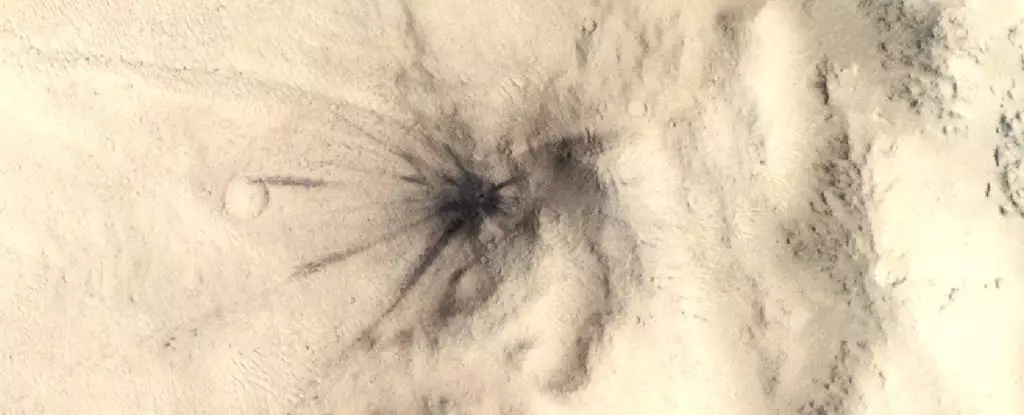The red planet, often viewed through the lens of curiosity and exploration, has presented a new dimension of its seismic activity, revealing that our previous notions about its geological stability may be far from accurate. Recent research integrating advanced artificial intelligence techniques has unveiled a significant paradigm shift in how we comprehend the seismic mechanisms operating within Mars. Specifically, scientists have discerned that many marsquakes may not originate from geological activity within the planet but are instead closely associated with meteoroid impacts. This startling finding, which originated from a university-led study, underscores a need to substantially revise our understanding of Mars’ geological past and present.
Mars has long been considered a relatively inert world with limited geological activity. The Mars InSight lander, a remarkable feat of engineering that operated from 2018 to 2022, provided a wealth of data by recording numerous seismic events—over 1,300 quakes to be precise. While the majority of these events had been thought to stem from internal geological activities such as tectonics or magma movements, the introduction of artificial intelligence into seismic data analysis has illuminated a complex interplay that calls for a reevaluation of Mars’ seismic landscape.
Valentin Bickel, a leading planetary scientist from the University of Bern, accentuates the implication of these findings: the assumption that Mars is significantly quiet is profoundly challenged. The revelation that a considerable number of detected quakes correlate with meteoroid impact events shifts the focus toward understanding Mars not just as a dormant body, but as a celestial object subjected to frequent bombardments. The study identified an estimated impact rate on Mars that is approximately 1.6 to 2.5 times higher than earlier predictions, altering the fundamental assumptions of how many extraterrestrial bodies get influenced by their environments.
Utilizing machine learning algorithms, Bickel and his team ingeniously cross-referenced seismic data with images from the HiRISE instrument aboard the Mars Reconnaissance Orbiter. This meticulous approach led to the identification of 123 new craters, with 49 seismic events linked directly to meteoroid impacts. This substantial influx of data poses considerable challenges to previously accepted models of Martian geology, suggesting that Mars is far more dynamic than previously believed.
One of the significant revelations from the recent analysis revolves around the propagation of seismic waves. Instead of being confined to the planet’s crust, it appears these waves traverse deeper into Martian interiors through more extensive networks than previously understood. This concept of a ‘seismic highway’ suggests that impact-generated waves can travel significant distances within the planet’s mantle, thus changing our ability to map the internal composition of Mars based on seismic activity.
The implications are profound. As scientists like Constantinos Charalambous from Imperial College London clarify, the previous model that attributed high-frequency seismic signals exclusively to geologically induced quakes must be reassessed. The link between impacts and seismic signals fundamentally alters our perspective of the Cerberus Fossae region, known for its volcanic history, and hints that our topographical interpretations may need considerable refinement.
The quest to understand Mars’ geological makeup transcends mere curiosity; it holds vital implications for broader planetary science inquiries. By drawing parallels between Earth, Mars, and even Venus, researchers can enhance their understanding of planet formation and evolution across the solar system. Each discovery about Mars not only sheds light on its unique attributes but also potentially enriches our understanding of terrestrial processes and the histories of our neighboring planets.
Moreover, this research illustrates the value of integrating artificial intelligence into planetary science. The ability to analyze vast datasets and identify subtle patterns can lead to breakthroughs that traditional methods might overlook. As we progress in our quest to understand Mars, it becomes increasingly clear that the red planet still harbors a wealth of secrets beneath its dusty surface.
With groundbreaking insights stemming from the intersection of artificial intelligence and traditional geological research, it is fitting to proclaim that Mars is not, in fact, the geological ghost town we once presumed. The ongoing reevaluation of seismic activities paves the way for a new era in Martian study—one that beckons obstacles to be investigated and mysteries to be unraveled. This renewed perspective challenges scientists and space enthusiasts alike to reconsider the vast implications of a dynamic Martian environment: an ever-evolving narrative within our solar system. As we continue to explore Mars, each revelation on this enigmatic planet holds the promise of redefining how we perceive planetary formation and dynamics.


Leave a Reply